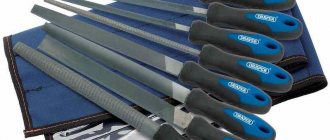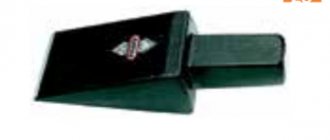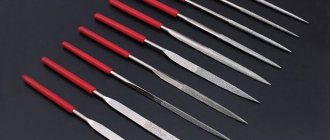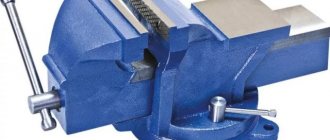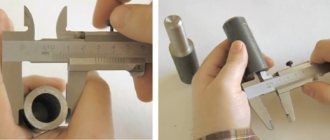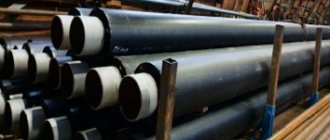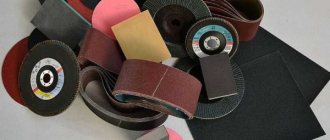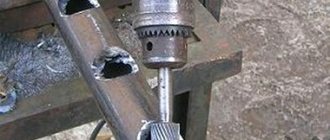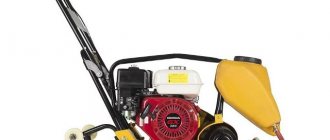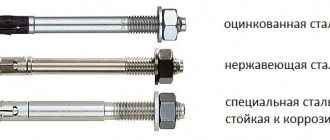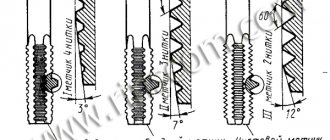When performing construction work, the use of various measuring instruments is required. One of these are squares, or as they are also called, calibration instruments. It helps to track the exact perpendicular between two surfaces. What a construction square is, what types of these tools there are, and how to choose them correctly is described in detail in the material.
What is a square and what is it used for?
A square is a measuring tool consisting of two rulers located at an angle of 90 degrees to each other. It is used in various fields - in construction, plumbing and carpentry, in production, etc. The main purpose of this device is to draw straight lines located perpendicular to each other.
The square is also called a testing square, since it is used to check structures for defects. Many people use this tool only to draw straight lines at an angle of 90 degrees, and do not even realize that the device can also draw a line at any other angle.
The main advantage of the tool in question is that it has a simple design. This affects not only its cost, but also the possibility of making it yourself. To make a square, you will need to connect two rulers, placing them perpendicular to each other. Using the resulting device, you can draw not only perpendicular lines, but also parallel ones.
This is interesting!
The square is the main tool of carpenters, builders and masons, as it helps to quickly and accurately measure right angles.
Square in carpentry
If you bend a carpenter's ruler at an angle of 90°, you get the simplest carpenter's square for marking lines and corners. With its help, you can draw parallel and perpendicular lines on walls during repair and construction work, check corners and make markings in furniture production. It is indispensable when creating any carpentry structures.
The materials used to create modern squares are wood, plastic, metal and their combinations.
School angles are usually made in two types - with angles 30°×60°×90° and 45°×45°×90°. In this case, one of the sides is usually made in the form of a ruler with marked divisions (mm and cm).
Squares for carpentry work often have the shape of the letter “G”; they are also called corners.
The angle consists of a ruler (usually from 60 mm to 1600 mm long), which is fixed in a wooden, metal or plastic handle, depending on the quality and level requirements of the tool. It serves not only to check right angles, but also to draw perpendicular lines.
For a more complete discussion of the topic, read our article on the Svenson carpenter's square.
What are angles made of?
Modern squares are made from materials such as wood, plastic and metal. The most reliable are metal tools that are not subject to deformation, which is very important when performing construction and repair work. One or two guides have scales through which you can control the distance.
The length of the guides ranges from 60 to 1600 mm, which depends on the scope of the tool. The device has an L-shape, so among specialists who use these tools, you can find the name corner. A universal square is a small square. Unlike a square, the angle grinder has a hinged joint, which allows you to determine not only right angles.
Metal squares are made of carbon steel of the following grades:
- X
- U8A
- 9X
- ШХ15
During the manufacturing process, the tool is subjected to heat treatment, which allows the part to be hardened to a high hardness of 50-58 HRC. Manufacturers produce squares of three accuracy classes - 0, 1 and 2. The most accurate are devices with a zero accuracy class, which are used in metrology laboratories and verification services. Devices with accuracy class 1 are used by specialists - masons, carpenters, mechanics, welders. Less precise instruments belonging to the second class are used in everyday life by home craftsmen.
This is interesting!
A square is also an isosceles right triangle in which two sides are at right angles. A tool of this shape is more accurate due to the fact that it has the same rigidity on any part of the plane.
Time-tested tools!
Since ancient times, craftsmen working with stone and wood used a measuring device, later called a ruler. To help mark out the material and check compliance with the calculations, another device was added over time - two rulers crossed strictly at right angles. Both of these tools have undergone many changes over many centuries, but have not changed their essence: they help the master to mark out the site, materials, parts, and then control the progress and quality of the work.
The square even found its place in history: together with the compass, it is considered a symbol of the work of masons and carpenters, there is also a connection with church teaching - the attributes of the Apostle Thomas, who patronized builders, are called the ruler and the square, and the Freemasons call it one of their symbols.
Arithmetic and geometry, or rather their image, in the seven liberal arts was personified by the square. Well, you and I know him well thanks to these sciences and school mathematics lessons. Wooden, plastic or metal school squares are traditionally triangular in shape, isosceles with two angles of 45 degrees or scalene of 30 and 60 degrees. It is impossible to imagine completing tasks without them. In adult life, their goals and objectives are the same, but their role is much larger.
Types of test squares and features of their use
Verification products are classified into five types, which allows them to be used in various fields. Let's look at all types of testing devices and find out their purpose.
- UL - pattern. The scope of application of this type of tool is for marking and performing plumbing and assembly operations. Using a measuring device, you can control the perpendicularity of individual structural elements. High measurement accuracy is ensured by sharp measuring surfaces. One side of the tool has a short thick part, and the second long side has a thinned profile
- ULP - patterned flat also has one short and the second elongated part, only with the same profile thickness. The main purpose of the ULP tool is to carry out marking work on flat surfaces
- ULC - a patterned cylindrical device has the appearance of a hollow cylinder with chamfers. The base of the device and the side surface have a right angle equal to 90 degrees. Cylindrical squares are used as standard or reference tools in metrology stations and in mechanical engineering. The device is produced with zero and first class accuracy
- UP - flat. Consists of two sides located at an angle of 90 degrees. All sides of the tool are flat, and it is available in three types of accuracy - 0, 1 and 2
- USH - with a wide base. The tool is designed to check the perpendicularity of planes. The wide base allows you to install the device on a plane without the use of auxiliary devices
Squares are also divided into three main types, which we will consider in the next section.
The best professional models of construction squares
Wolfcraft 5206000 500×280 mm
The rating of quality products opens a model that is used to make accurate measurements. It is characterized by increased accuracy of measurements, which are so necessary in drawing and marking work. The device is convenient to use in everyday life. Special notches that are placed on the surface of the body are responsible for the accuracy of the applied parallel lines and marking of corners. Increased convenience during the measurement work was achieved through the installation of a proprietary sopper.
Such manipulations will not take a lot of effort and time from a person. Can be used when performing work that requires increased accuracy. High quality stainless steel is used for production. The material is lightweight and, at the same time, durable. This solution made it possible to significantly increase the service life of the product. When folded, the product will not take up much space due to its compact dimensions and short length.
The model is in high demand among professional builders who give preference to the high quality and accuracy of the tools used. It is based on the use of precision equipment. The product has found its application in marking perpendicular products, as well as carpentry and joinery work.
Cost – 1750 rub.
Wolfcraft 5206000 500×280 mm
Advantages:
- accuracy of the manipulations;
- long service life;
- wide base;
- increased ease of use;
- presence of double-sided markings;
- quality raw materials;
- compliance with GOST 427-75;
- multifunctionality;
- professional model.
Flaws:
- not identified.
Bahco 9045-B-200
This professional type tool is used to check right angles. The stamping method is responsible for the high service life and build quality. High quality steel alloy is used for manufacturing. The presence of a protective coating, which eliminates the risk of corrosion, deserves special attention. Allows marking with increased accuracy within 45-90°. Characterized by increased stability when working on planes. It should also be noted that during long-term use the master’s hands will not get tired.
You can purchase a new product at a price of 1600 rubles.
Bahco 9045-B-200
Advantages:
- the presence of a protective coating;
- application of modern production technologies;
- high quality of assembly and raw materials;
- sustainability;
- optimal balance.
Flaws:
- not identified.
STANLEY 2-46-222
This design belongs to the combined category. With its help you can take measurements within 45°. The product is also equipped with a spirit level and a depth gauge - a nice addition that is so necessary for specialists when performing everyday manipulations. It is characterized by the presence of optimal strength and wear resistance, which makes it possible to increase the service life. The aluminum base is made using casting technology. Three milled surfaces deserve special attention. The device copes with the indicated functions no worse than its electronic counterparts. An inch scale is installed, which may seem inconvenient to many. If necessary, it is possible to use a metric scale, which is also available.
How much does the product cost? The purchase will cost 850 rubles.
STANLEY 2-46-222
Advantages:
- service life;
- quality of raw materials and related components;
- ease of use;
- multifunctionality;
- two scales;
- durable cast base.
Flaws:
- not identified.
Cobalt 243-479 300×100 mm
This model is based on the use of a 30 cm universal type level. This allows several types of manipulations to be carried out simultaneously using one device. The linear measuring device does an excellent job of identifying irregularities using an existing level. It is based on the use of a blade made of high-strength stainless steel. For greater ease of use, there is a bubble ampoule. The device is used for marking when working with tiles, as well as metal, plastic, glass and wooden structures.
It copes well with vertical alignment of products. Detects contact angles and helps control the horizon. Allows linear measurement of elements. The tool is in demand among mechanics, carpenters and furniture manufacturers. High-strength stainless steel is used for production. The base is made of aluminum, which eliminates the risk of the tool slipping. The design is convenient to use in everyday life due to the presence of a double-sided scale. The device can be fixed at any point on the guide. The device consists of two surfaces that are at an angle of 45/90°. The spirit level is equipped with two auxiliary marks that will allow you to design the flow of liquids. The hardened steel scriber deserves special attention.
Cost – 580 rub.
Cobalt 243-479 300×100 mm
Advantages:
- excellent equipment;
- professional model;
- high-quality raw materials and consumables;
- two-sided scale;
- auxiliary markings;
- anti-slip base;
- multifunctionality.
Flaws:
- not identified.
What types of angles are there?
There are the following types of angles used in different fields of activity:
- Carpentry - used by carpenters. Available in different lengths from 10 cm to 10 meters
- Marking - tools of this type have graduated sides with holes for marking with a pencil. Such tools are used in the field of furniture manufacturing. The device is used to check perpendicularity, apply markings, and also calibrate other devices.
- Universal or combined - has a swivel joint, which allows you to adjust the required angle. The handle of the device is equipped with a bubble level and a holder. Universal squares combine a number of the following tools: surface thicknesser, mortar, ruler and planer
This is interesting!
Erunko is a corner in which two guides are attached at an angle of 45 or 135 degrees.
How to choose the right square for the job
Knowing what types and types of squares there are, you can start choosing a tool. If you plan to use the device in a home workshop, then it is not at all necessary to buy a reference corner. For home use, tools with accuracy class 2 are used. When choosing, it is also important to consider the following recommendations:
- Size - the longer the sides of the corner, the higher the measurement accuracy. If you plan to determine the corners of large structures, then you should choose devices with guide lengths of up to 6 meters. If the device is used for marking ceramic tiles or bricks, then devices with a length of 15-30 cm are suitable for this.
- Measurement angle - if you plan to use the device for marking perpendicular sides, then you need to choose inexpensive options for classic squares with a fixed connection
- Availability of markings - allows you to use the tool not only for marking perpendiculars, but also as a ruler
- Quality of fixation - the longer the guides of the device, the thicker they should be. If the length of the ruler is large, but at the same time it is thin, this will lead to a large measurement error
- Material of manufacture - metal squares are not always convenient to use, so you need to try the device before purchasing. Some craftsmen prefer to use wooden or plastic utensils
There are no difficulties in using the tool. To do this, you need to attach the tool to the plane and draw a perpendicular line. If the accuracy of a right angle is being checked, then the end part of the tool is applied to two perpendicular surfaces, and the check is performed.
The cost of the square depends on the material of manufacture, length, thickness of the guides and quality of workmanship. This is an indispensable tool that should be not only in the arsenal of specialists, but also of home craftsmen.
In conclusion, it should be noted that a square is the simplest tool that is easy to use, and at the same time allows you to make a structure with high accuracy of right angles. Moreover, the tool is designed not only to control the internal corners of various connections, but also the external ones.
